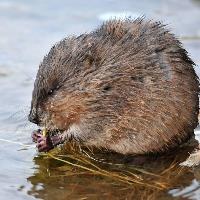(BRUSSELS) – The muskrat and alligator weed were among 12 new species added to the European Commission’s list of invasive alien species that require action across the EU, part of EU efforts to halt biodiversity loss.
Invasive alien species are a major cause of biodiversity loss. They have major economic negative consequences in areas such as health care costs, crop yield losses, fish stock losses and damage to infrastructure.
The 12 new species have been added following a positive opinion of experts from Member States. They damage on a scale that justifies dedicated measures across the Union.
EU Member States are now required to address these species by preventing them from being introduced, kept, sold, transported, reproduced or released.
They will also need to put in place appropriate measures to tackle new invasions or established populations.
The rules start to apply 20 days after publication of the list in the Official Journal of the European Union.
Underpinning with scientific work, the Commission’s Joint Research Centre has recently published the first ever Baseline Distribution of Invasive Alien Species of Union concern for 37 species.
It has also developed a smartphone application on the 37 species of Union concern, called Invasive Alien Species Europe, which allows citizens to report the presence of these species on the European territory and to raise awareness on the issue.
Invasive alien species (IAS) are non-native species whose introduction and/or spread outside their natural, past or present, ranges pose a threat to biodiversity.
Invasive alien species occur in all major groups, including animals, plants, fungi and micro-organisms, and are considered, at least on islands, to be the second most important reason for biodiversity loss worldwide (after direct habitat loss or destruction).
About 10,000 alien species have been registered in Europe. Some of these species were introduced on purpose and remain economically important. However, a proportion of the alien species established cause significant damage to native biodiversity and can be classified as invasive alien species according to the Convention on Biological Diversity.
Invasive species can cause great damage to native species by competing with them for food, eating them, spreading diseases, causing genetic changes through inter-breeding with them and disrupting various aspects of the food web and the physical environment.
The Annex to Commission Implementing Regulation (EU) No 2016/1141 is amended as follows:
(1) In the table of the list of invasive alien species of Union concern, the following
species are inserted in alphabetical order:
| “Alopochen aegyptiacus Linnaeus, 1766 | ex 0106 39 80 | ex 0407 19 90 (fertilised eggs for incubation) |
|
| Alternanthera philoxeroides (Mart.) Griseb. | ex 0602 90 50 | ex 1209 99 99 (seeds) | (12) |
| Asclepias syriaca L. | ex 0602 90 50 | ex 1209 99 99 (seeds) | (7) |
| Elodea nuttallii (Planch.) St. John | ex 0602 90 50 | ex 1209 99 99 (seeds) | |
| Gunnera tinctoria (Molina) Mirbel | ex 0602 90 50 | ex 1209 99 99 (seeds) | |
| Heracleum mantegazzianum Sommier & Levier | ex 0602 90 50 | ex 1209 99 99 (seeds) | |
| Impatiens glandulifera Royle | ex 0602 90 50 | ex 1209 99 99 (seeds) | |
| Microstegium vimineum (Trin.) A. Camus | ex 0602 90 50 | ex 1209 99 99 (seeds) | (7), (12) |
| Myriophyllum heterophyllum Michaux | ex 0602 90 50 | ex 1209 99 99 (seeds) | |
| Nyctereutes procyonoides Gray, 1834(*) | ex 0106 19 00 | — | |
| Ondatra zibethicus Linnaeus, 1766 | ex 0106 19 00 | — | |
| Pennisetum setaceum (Forssk.) Chiov. | ex 0602 90 50 | ex 1209 99 99 (seeds) |
(*) The inclusion of Nyctereutes procyonoides Gray, 1834 shall apply as of [Office of
Publications please insert date 18 months after entry into force.].”



